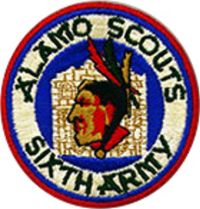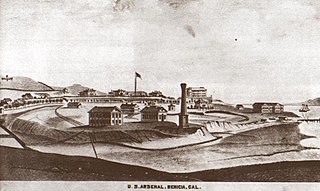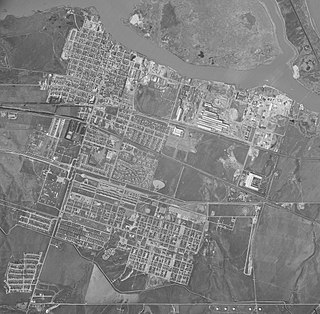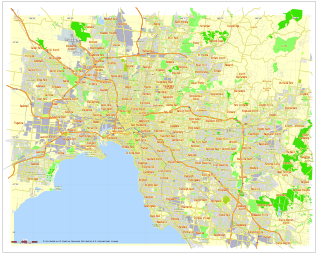
A prisoner of war (POW) is a person who is held captive by a belligerent power during or immediately after an armed conflict. The earliest recorded usage of the phrase "prisoner of war" dates back to 1610.
Fort Lee, in Prince George County, Virginia, United States, is a United States Army post and headquarters of the United States Army Combined Arms Support Command (CASCOM)/ Sustainment Center of Excellence (SCoE), the U.S. Army Quartermaster School, the U.S. Army Ordnance School, the U.S. Army Transportation School, the Army Logistics University (ALU), Defense Contract Management Agency (DCMA), and the U.S. Defense Commissary Agency (DeCA).

Hiwi, the German abbreviation of the word Hilfswilliger or, in English, auxiliary volunteer, designated, during World War II, a member of different kinds of voluntary auxiliary forces made up of recruits indigenous to the territories of Eastern Europe occupied by Nazi Germany. Adolf Hitler reluctantly agreed to allow recruitment of Soviet citizens in the Rear Areas during Operation Barbarossa. In a short period of time, many of them were moved to combat units.

The Italian resistance movement is an umbrella term for the Italian resistance groups who fought the occupying forces of Nazi Germany and the fascist collaborationists of the Italian Social Republic during the Second World War in Italy from 1943 to 1945. As an anti-fascist movement and organisation, La Resistenza opposed Nazi Germany, as well as Nazi Germany's Italian puppet state regime, the Italian Social Republic, which was created by the Germans following the Nazi German invasion and military occupation of Italy by the Wehrmacht and the Waffen-SS from September 1943 until April 1945.

The 92nd Infantry Division was an African-American infantry division of the United States Army that served in both World War I and World War II. The military was then segregated. The division was organized in October 1917, after the U.S. entry into World War I, at Camp Funston, Kansas, with African-American soldiers from all states. In 1918, before leaving for France, the American buffalo was selected as the divisional insignia due to the "Buffalo Soldiers" nickname, given to African-American cavalrymen in the 19th century. The divisional nickname, "Buffalo Soldiers Division", was inherited from the 366th Infantry, one of the first units organized in the division.

The Alamo Scouts was a reconnaissance unit of the Sixth United States Army in the Pacific Theater of Operations during World War II. The unit is best known for its role in liberating American prisoners of war (POWs) from the Japanese Cabanatuan POW camp near Cabanatuan, Nueva Ecija, Philippines in January 1945.

The Benicia Arsenal (1851–1964) and Benicia Barracks (1852–66) were part of a large military reservation located next to Suisun Bay in Benicia, California. For over 100 years, the arsenal was the primary US Army Ordnance facility for the West Coast of the United States.

The Italian Co-belligerent Army, or Army of the South were names applied to various division sets of the now former Royal Italian Army during the period when it fought alongside the Allies during World War II from October 1943 onwards. During the same period, the pro-allied Italian Royal Navy and Italian Royal Air Force were known as the Italian Co-belligerent Navy and Italian Co-belligerent Air Force respectively. From September 1943, pro-Axis Italian forces became the National Republican Army of the newly formed Italian Social Republic.
Camp Ellis was a United States World War II Army Service Forces Unit Training Center and prisoner-of-war camp between the towns of Bernadotte, Ipava, and Table Grove in Fulton County, Illinois. Construction began on 17 September 1942, and the camp opened on 16 April 1943, with an official dedication 14 July 1943. German prisoners of war were guarded by the 475th and 476th Military Police Escort Guard Companies. Training activities ended in November 1944.

This article is about the Royal Italian Army which participated in the Second World War. The Royal Italian Army was reformed in 1861 and existed until 1946. The Royal Army started with the unification of Italy (Risorgimento) and the formation of the Kingdom of Italy. It ended with the dissolution of the monarchy. The Royal Army was preceded by the individual armies of the independent Italian states and was followed by the Italian Army of the Italian Republic.
Camp Livingston was a U.S. Army military camp during World War II. It was located on the border between Rapides and Grant Parishes, near Pineville, 12 mi (19 km) north of Alexandria, Louisiana.

The National Republican Army was the army of the Italian Social Republic from 1943 to 1945 that fought on the side of Nazi Germany during World War II.

Camp Stoneman was a United States Army facility located in Pittsburg, California. It served as a major troop staging area for and under the command of the San Francisco Port of Embarkation (SFPOE). The camp operated during World War II and the Korean War.
Brent Prescott's Camp Ono existed from 1942 to 1947 in Southern California on 300 acres of land. The camp was four miles northwest of the City of San Bernardino, California.
The 620th Engineer General Service Company was a United States Army Corps of Engineers company active during World War II whose rank and file were American soldiers, both native and foreign born who were suspected of disloyalty or subversion.

The Temporary Detention Camp for Japanese Americans / Pomona Assembly Center is one of the places Japanese Americans were held during World War II. The Pomona Assembly Center was designated a California Historic Landmark on May 13, 1980. The Pomona Assembly Center is located in what is now called the Fairplex in Pomona, California in Los Angeles County. The Pomona Assembly Center was called Los Angeles County Fairgrounds in 1942.

California during World War II was a major contributor to the World War II effort. California's long Pacific Ocean coastline provided the support needed for the Pacific War. California also supported the war in Europe. After the Japanese attack on Pearl Harbor, Hawaii, on December 7, 1941, most of California's manufacturing was shifted to the war effort. California became a major ship builder and aircraft manufacturer. Existing military installations were enlarged and many new ones were built. California trained many of the troops before their oversea deployment. Over 800,000 Californians served in the United States Armed Forces. California agriculture, ranches and farms were used to feed the troops around the world. California's long coastline also put the state in fear, as an attack on California seemed likely. California was used for the temporary and permanent internment camps for Japanese Americans. The population of California grew significantly, largely due to servicemen who were stationed at the new military bases/training facilities and mass influx of workers from around the U.S. in the growing defense industries. With all the new economy activity, California was lifted out of the great depression. Over 500,000 people moved to California from other states to work in the growing economy. California expanded its oil and mineral production to keep up with the war demand.

Camp Haan was a US Army training camp built in 1940, near March Air Force Base in Riverside County, California Camp Haan was opened in January 1941 as a training camp for Coast Artillery Antiaircraft gunners. The 8,058 acres camp was about four miles by three miles with tent housing. The camp was named after Major General William George Haan of World War I. By the end of 1941, the camp had a wood service building, 28 miles of streets, five chapels, and a hospital. The first troops trained were sent for the defense of Los Angeles and San Francisco. The Attack on Pearl Harbor and the Battle of Los Angeles–Bombardment of Ellwood had put all of California on high alert. The Army Service Depot was added to the camp in March 1942. The site of the former Camp Haan is next to California Interstate 215 at the Van Buren Boulevard exit.

Naval Base Melbourne was a United States Navy base at Melbourne during World War II. Naval Base Melbourne became the South West Pacific Area Command Headquarters after the 1941 invasion of the Philippines. General Douglas MacArthur, after escaping the Philippines, set up his Headquarters after his arrival on 21 March 1942. MacArthur was appointed Supreme Commander of all Allied Forces in the South West Pacific Area. The US Navy also set up a Headquarters a Melbourne, Allied Naval Forces Southwest Pacific Area under Commander Vice Admiral Herbert F. Leary. MacArthur and Leary used the empty Trustees Executive building at 401 Collins Street, Melbourne for headquarters. The Port of Melbourne had good fleet anchorage and docks. A new naval base was built at Brisbane, Australia, Naval Base Brisbane, and the Headquarters was moved to Brisbane in July 1942.













